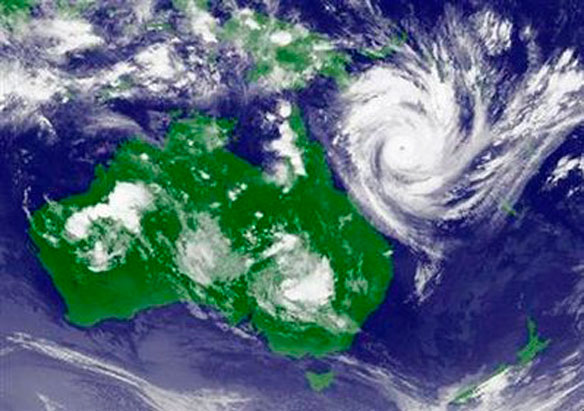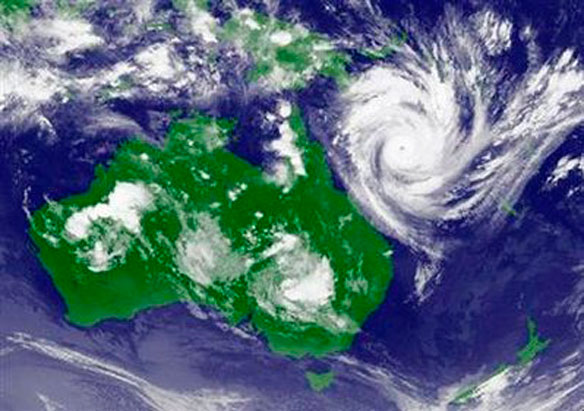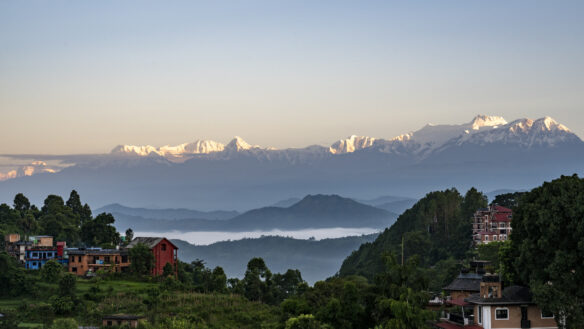
By Rob Taylor, Reuters
One of the most powerful cyclones on record slammed into Australia’s northeast coast on Thursday, tearing off roofs and bringing down power lines but there were no reports of deaths as first light broke.
Cyclone Yasi, packing winds of up to 300 km (186 miles) an hour near its core, came ashore along hundreds of kilometers of coastline in Queensland state.
Mines, rail lines and coal ports have been shut, with officials warning the storm could drive far inland, hitting mining areas struggling to recover from recent devastating floods.
Queensland accounts for about a fifth of Australia’s economy and 90 percent of its steelmaking coal exports but the extent of the damage might not be known for many hours.
The eye of the cyclone crossed the coast close to the tourist town of Mission Beach at around midnight.
“It sounds like a roaring train going over the top of the house. There are trees cracking outside,” Hayley Leonard told Seven Network television from a concrete bunker beneath her home in the town of Innisfail.
Despite the ferocity of the cyclone, Queensland Premier Anna Bligh said there had been no reports of deaths.
“What I’m very relieved about is that we have yet to hear any reports from any police or any other source of any serious injury or fatality,” Bligh told Sky TV.
She said evacuation centers, where more than 10,000 people had sheltered across the state, had not reported structural damage.
Major towns in the area including Cairns and Townsville appeared to escape the full brunt of the storm, but Bligh said “devastating damage” was expected in smaller communities.
Power was cut in the western side of Cairns and a power official said more than 170,000 residents were without power.
Yasi was rated a maximum-strength category five storm and drew comparisons with Hurricane Katrina, which wrecked New Orleans in 2005.
It has been downgraded to a category two storm as it moves inland. But its core remained very destructive, the Bureau of Meteorology said.
Almost everyone in the storm zone was bunkered down at home or in cyclone shelters. Tens of thousands of people were evacuated in the hours before the storm struck.
A Bureau of Meteorology spokesman said a storm surge of two meters (six feet) above the normal level of the tide had inundated one stretch of coast but reporters said the surges were not as severe as feared.
More than 400,000 people live in the cyclone’s path. The entire stretch is popular with tourists, includes the Great Barrier Reef, and is home to major coal and sugar ports.
The storm could inflate world sugar, copper and coal prices, after forcing a copper refinery to close and paralyzing sugar and coal exports. It even prompted a major mining community at Mt Isa, almost 1,000 km (620 miles) inland, to go on alert.
Global miners BHP Billiton and Peabody Energy had shut several coal mines, an official for the union representing Queensland coal miners told Reuters.
Engineers warned that Yasi could even blow apart “cyclone proof” homes when its center moved overland, despite building standards designed to protect homes from a growing number of giant storms.
“I think all the roof is gone,” Ray, one resident of a town south of Innisfail, told ABC news. “It just sounded like an automatic rifle going bang, bang, bang, bang as it went.”
Bligh said the cyclone could batter the state for up to three days as it moved inland.
She said a giant nine-meter (30-foot) wave had been recorded off the coast on Wednesday.
Satellite images showed Yasi as a massive storm system covering an area bigger than Italy. It is predicted to be the strongest ever to hit Australia.
Prime Minister Julia Gillard has put 4,000 soldiers based in Townsville on standby to help once the cyclone passes, as well as military ships and helicopters.
Queensland has had a cruel summer, with floods sweeping across it and other eastern states in recent months, killing 35 people.
The state is also home to most of Australia’s sugar industry and losses for the industry from Yasi could exceed A$500 million, including crop losses and damage to farming infrastructure, industry group Queensland Canegrowers said.
Bligh said there had been reports of damage to crops. Near the town of Innisfail, banana plantations had been ripped out of the ground.
Exploring Links Between Stronger Hurricane and Low Lying Coastal Zones, in Coastal Care
Mangroves as Lives Saver When Natural Disaters Strike, in Coastal Care









